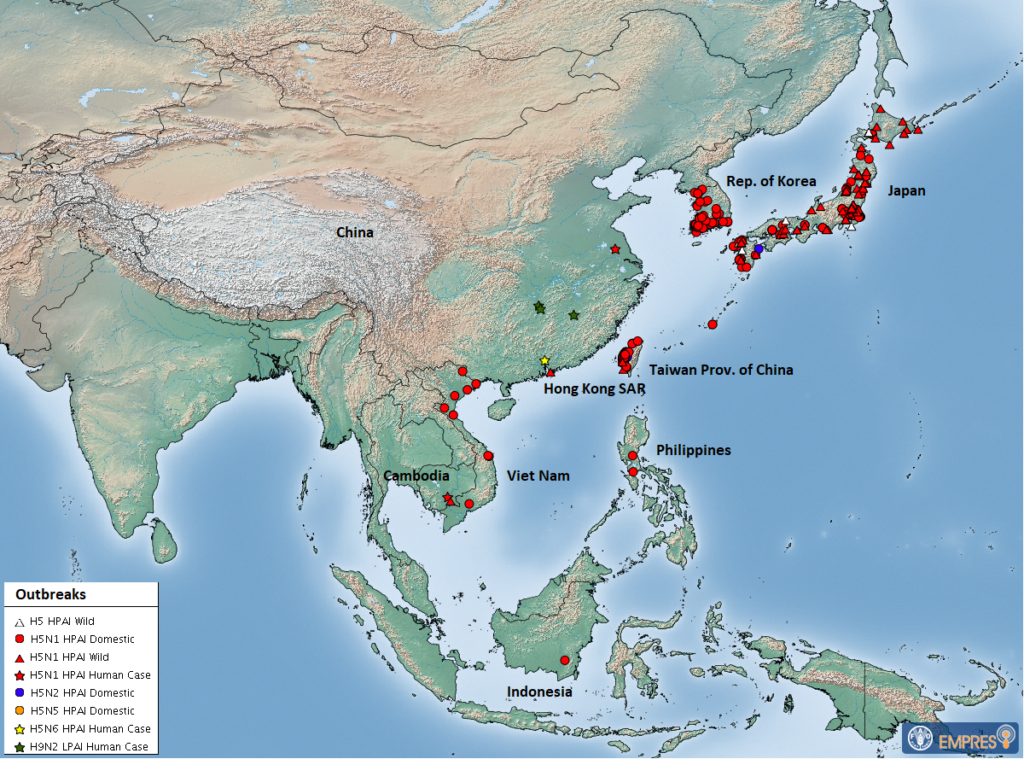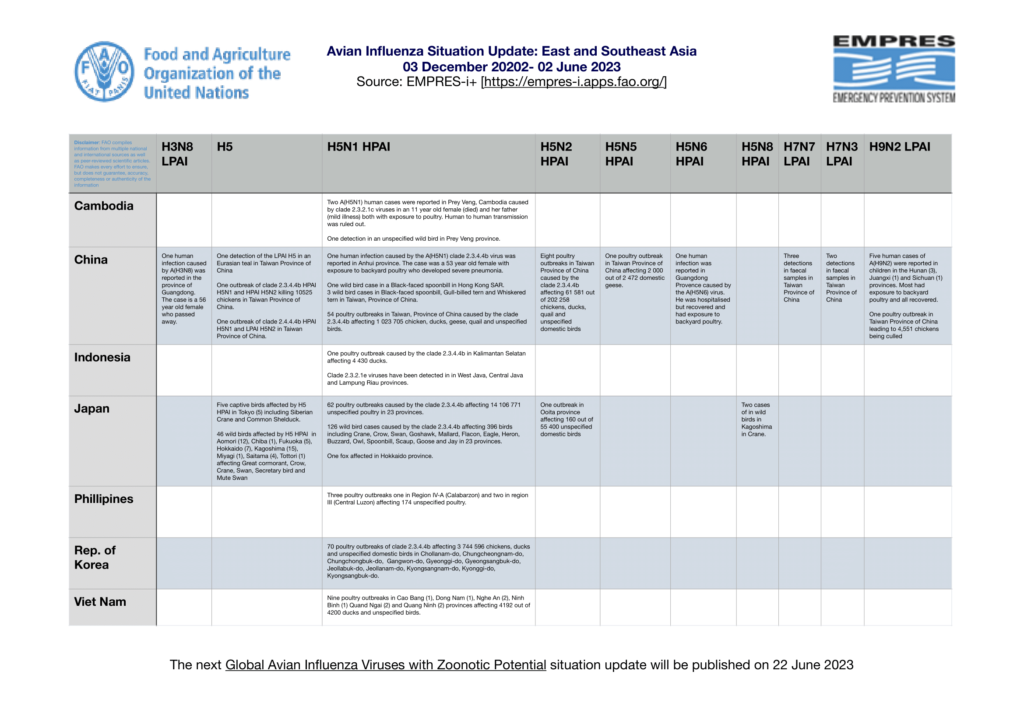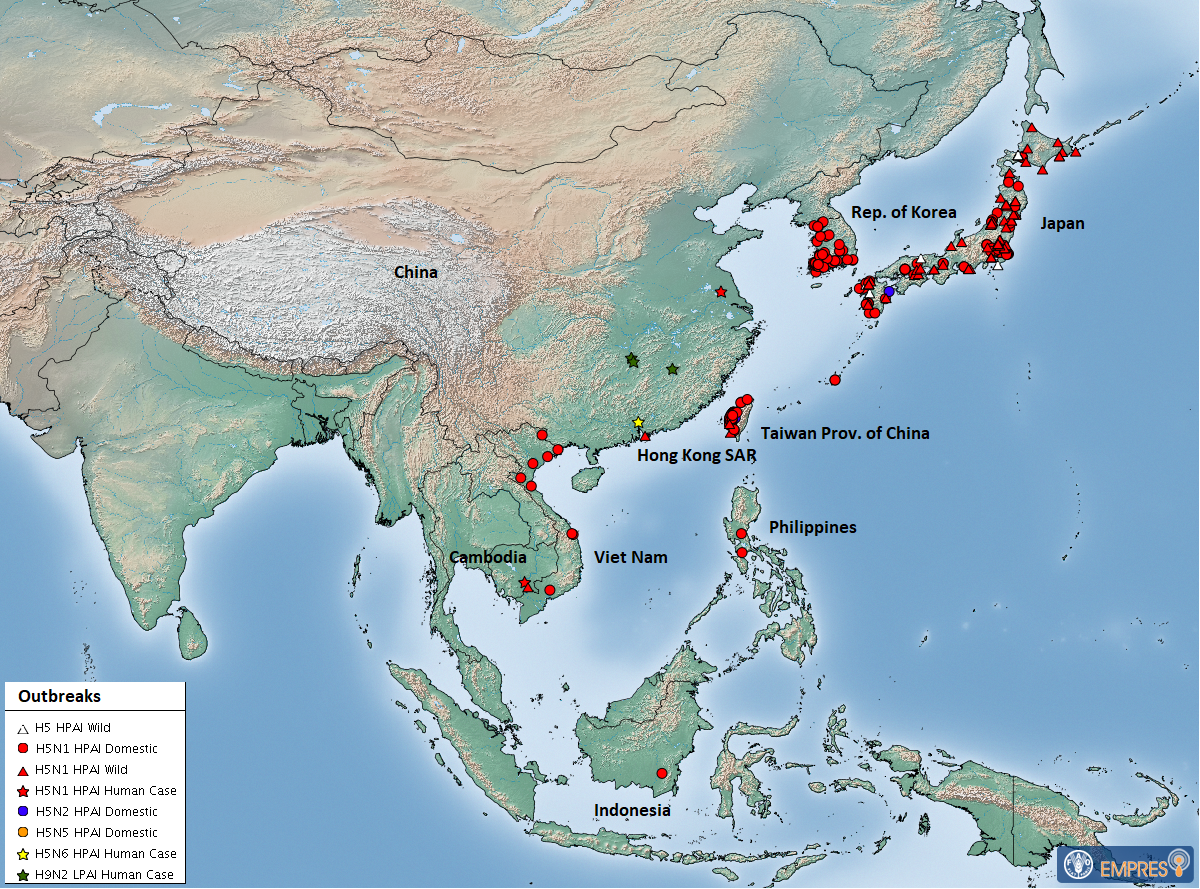FAO/EMPRES-AH is constantly monitoring the avian influenza situation worldwide and compiles information from multiple national and international sources as well as peer-reviewed scientific articles. In close collaboration with country and regional offices, the implementation of avian influenza field surveillance projects, and networks of expertise like WOAH/FAO’s OFFLU (www.offlu.org) provide access to timely information on outbreaks, surveillance findings, and genetic similarities of circulating viruses or their virological features. This information is stored in the EMPRES Global Animal Disease Information System (EMPRES-i), a database that can be accessed online at https://empres-i.apps.fao.org/.

Avian Influenza in East and Southeast Asia from December 2022 to June 2023 ©EMPRES-I
During the period of 3 December to 2 June 2023, six highly pathogenic avian influenza (HPAI) virus subtypes (H5, H5N1, H5N2, H5N5, H5N6, and H5N8) and five low pathogenic avian influenzas (LPAI) virus subtypes (H3N8, H5N2, H7N7, H7N3, and H9N2) have been reported detected in Eastern and South-eastern Asia. H5Nx HPAI viruses continue to circulate in Eastern and South-eastern Asia and reported detections increased since the last report.
Within the reporting period, HPAI outbreaks occurred in Cambodia which reported an H5N1 detection in an unspecified wild bird in Prey Veng province caused by the clade 2.3.2.1c. Japan reported HPAI H5, H5N1, and H5N8 affecting numerous species of captive and wild birds including Crane, Crow, Swan, Goshawk, Mallard, Flacon, Eagle, Heron, Buzzard, Owl, Spoonbill, Scaup, Goose, Duck, and Jay as well as outbreaks in poultry caused by H5N1 and H5N2 subtypes leading to the culling of over 14 million birds in 32 provinces. In the Republic of Korea, there were reports of 70 H5N1 outbreaks of clade 2.3.4.4b which affected nearly 4 million domestic poultry in the regions of Chollanam-do, Chungcheongnam-do, Chungchongbuk-do, Gangwon-do, Gyeonggi-do, Gyeongsangbuk-do, Jeollabuk-do, Jeollanam-do, Kyongsangnam-do, Kyonggi-do and Kyongsangbuk-do. Indonesia reported one poultry outbreak caused by the H5N1 clade 2.3.4.4b in Kalimantan Selatan affecting 4430 ducks. Clade 2.3.2.1e viruses have been detected in West Java, Central Java, and Lampung Riau provinces. Viet Nam officially reported nine poultry outbreaks in Cao Bang, Dong Nam, Nghe An, Ninh Binh Quand Ngai, and Quang Ninh provinces affecting 4192 out of 4200 ducks and unspecified birds
In China, Taiwan Province reported 66 poultry outbreaks caused by H5Nx, H5N1, H5N2, and H5N5 subtypes that lead to the destruction of over 1 million domestic poultry. Wild birds were affected by the H5, H5N1 subtypes affecting Eurasian teal, Black-faced spoonbill, Gull-billed tern, and Whiskered terns. One H5N1 HPAI detection was reported in Hong Kong SAR, China in Black-faced spoonbill.
Outbreaks in poultry caused by low pathogenic subtypes included H9N2 reported in Taiwan, the Province of China, and the H7N7 and H7N3 low pathogenic subtypes were detected in environmental samples.
In addition to outbreaks in avian species:
A(H5N1) was reported in a fox in Japan in April 2023. In the last update, Viet Nam reported one influenza A(H5) human infection in a 5-year-old female who had exposure to backyard poultry and ducks; the subtype has now been confirmed as A(H5N1). Since the last update A(H3N8) has been reported in Guangdong Provence in China in a 56-year-old female and A(H5N6) in a 49-year-old male. Two clades 2.3.2.1c A(H5N1) cases were reported in Cambodia in an 11-year-old girl (fatal) and her father (mild illness). In Anhui province, one clade 2.3.4.4b A(H5N1) human infection was reported in a 53-year-old female. 5 human cases of A(H9N2) were reported in children in the Hunan (3), Jiangxi (1) and Sichuan (1) provinces. Most of these cases reported exposure to backyard poultry and any human-to-human transmission has been ruled out.
Since 2014 (as of 3 June 2023), there have been 83 human cases of influenza A(H5N6) have been reported, 82 occurring in China and one in Lao People's Democratic Republic with the most recent case reported on 2 February 2023 with an onset of disease on 17 December 2022 in China.
Both the clade 2.3.2.1c and the clade 2.3.4.4b A(H5N1) have caused disease in humans since 2020. The most recent reports of each had an onset of 23 February 2023 and 31 January 2023 respectively.
To date 116 influenza A(H9N2) human cases have been reported worldwide with at least 96 cases reported in China since December 2015. The most recent case was reported on 9 March 2023 with an onset date of 5 February 2023 in China.
Highly pathogenic Goose/Guangdong lineage clade 2.3.4.4b H5Nx viruses have demonstrated the ability to spread long distances via migratory water birds. These viruses are continuing to infect an increasing range of wild bird species. This has led to an increase in infections reported in mammalian species which often display neurological symptoms. Globally the impacts on ecologically important birds, such as seabirds have been increasingly noted and are implicated in spread. Asia has experienced repeated incursions of the virus from multiple directions as well as circulation.
We expect avian influenza activity to maintain in Asia. Reports of outbreaks in poultry, detections in wild birds and occasional detections in mammalian species are expected to continue in the region over the coming months.

Please click [here] to view a larger version of the table above





